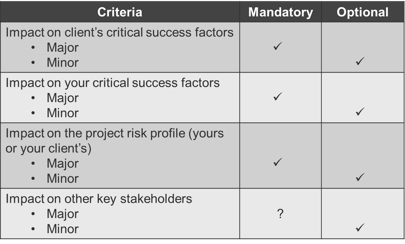When you identify that a project change may occur, the first thing that you, the project manager, has to do is figure out the source of the change. Until you determine that, you really cannot take the proper course of action. And so, it's important to know which of the following is the source of the change:
-
Did it come from someone on the internal project team?
-
Did it come from the client?
-
Or did it come from some third party, maybe a plan review agency or some public hearing or something like that?
IS THE CHANGE MANDATORY OR OPTIONAL?
 The next thing you have to look at is whether the change is mandatory or optional, i.e. do you absolutely have to make the change or maybe you do not need to. Consequently, there are a number of criteria to consider.
The next thing you have to look at is whether the change is mandatory or optional, i.e. do you absolutely have to make the change or maybe you do not need to. Consequently, there are a number of criteria to consider.
The first criteria to consider is what is the impact of that change on the client’s critical success factors. If the change has a major impact on the client’s critical success factors, it is mandatory, and you have got to make the change. On the other hand, if there is little or no impact on the client’s critical success factors, it is optional. Maybe you need to make the change and maybe you do not.
And then, you have to look at your critical success factors. Does the change have a major impact on your critical success factors? If so, you have got to deal with the change and make it. If not, maybe the change is optional.
Another element to look at is the risk profile for the project, which includes your project risks as well as the client’s project risks. If there is a major impact that increases the project risk profile, you have got to make the change. If the risk profile has little to no impact, then it is optional. Maybe you do and maybe you do not have to make the change.
And finally, what is the impact on other key stakeholders? If it has a minor impact on other key stakeholders, the change is optional. You may make it or you may not, at your discretion. If it has a major impact on other key stakeholders, it remains uncertain whether you have to make the change. Other key stakeholders are not parties to the contract. And so, you need to talk to your client to see if that change needs to be made depending on the client’s interpretation of what’s really important in terms of keeping the other key stakeholders satisfied.
 PSMJ has developed our library of interactive, expert-led sessions in response to the specific needs of A/E/C industry firms. Together with on-site training such as PSMJ’s A/E/C Project Management Bootcamp, firms now have the ability to train PMs matching a professional’s need to a platform. PSMJ's newest online learning courses are delivered in an interactive and engaging format to ensure PM's get action-oriented strategies and tactics that they can really use.
PSMJ has developed our library of interactive, expert-led sessions in response to the specific needs of A/E/C industry firms. Together with on-site training such as PSMJ’s A/E/C Project Management Bootcamp, firms now have the ability to train PMs matching a professional’s need to a platform. PSMJ's newest online learning courses are delivered in an interactive and engaging format to ensure PM's get action-oriented strategies and tactics that they can really use.
You also might be interested in these related blog posts:
10 Things Every Project Manager Must Know
5 Tools Every Project Manager Should Be Using
Are You a Project Manager or Project Admin?
What Are The Traits Of The Best Project Managers?



